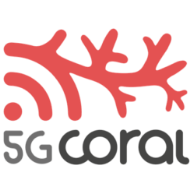
WORKSHOPS
IEEE BMSB 2018 will feature a wide technical and industry program covering the latest research and innovation in multimedia systems and broadcasting. The conference will include several workshops focusing on the upcoming 5G technology. IEEE BMSB 2018 will organize a main 5G workshop approaching the last innovations and research activities in 5G-PPP. Moreover, the conference will hold specific workshops organized by several 5G-PPP phase-2 projects: 5G-Xcast, IoRL, 5G-Transformer, 5G-CORAL, 5G-Ex, Bluespace, NGPaaS, 5G-MEDIA and 5GCAR.
Prospective authors are invited to submit papers on the topics of these workshops. All accepted and presented papers will be submitted for inclusion in IEEE Xplore® as part of the conference proceedings.
|
5G-PPP Main Workshop: Phase-2 in 5G-PPP: from Theoretical Studies to Proof-of-Concepts and Technology Demonstrators |
▼ |
|---|---|
Organizer: 5G-PPP Website: https://5g-ppp.eu/ Chairs: David Gómez Barquero (Universitat Politècnica de València, Spain) The 5G Infrastructure Public Private Partnership (5G-PPP) is a joint initiative between the European ICT industry and the European Commission to rethink the infrastructure and to create the next generation of communication networks and services that will provide ubiquitous super-fast connectivity and seamless service delivery in all circumstances. 5G-PPP is committed to the advancement of 5G in Europe and to build global consensus on 5G. | |
|
WS1: Point-to-Multipoint as Key Technology Element for 5G Systems |
▼ |
|---|---|
Organizer: 5G-Xcast Website: http://5g-xcast.eu/ Chair: Dr. Belkacem Mouhouche (Samsung Electronics R&D UK) Point-to-multipoint (PTM) will be demonstrated in 5G-Xcast thanks to a conceptually novel and forward-looking 5G network architecture for large scale immersive media delivery. PTM appears as part of the 5G vision of many stakeholders, including the 5G-PPP. 3GPP decided to prioritize the work in other areas for 5G Release (Rel)’15 and hence PTM is expected to be addressed from Rel’16. This creates an opportunity to develop novel solutions and contribute to the standardization work, by providing not only theoretical studies but also proof-of-concepts and demonstrators to experimentally test the proposed technologies over fixed, mobile and broadcast networks. | |
|
WS2: A Scalable and License Free 5G Internet of Radio Light Architecture for Services in Homes and Businesses |
▼ |
|---|---|
Organizer: IoRL Website: https://5g-ppp.eu/iorl-internet-of-radio-light-project-launch/ Chair: John Cosmas (Brunel University London) Wireless networks in buildings suffer from congestion, interference, security and safety concerns, restricted propagation and poor in-door location accuracy. The Internet of Radio-Light (IoRL) project develops a safer, more secure, customizable and intelligent building network that reliably delivers increased throughput (greater than 10Gbps) from access points pervasively located within buildings, whilst minimizing interference and harmful EM exposure, providing location accuracy of less than 10cm. | |
|
WS3: Second Edition of the Workshop on Control and Management of Vertical Slicing including the Edge and Fog Systems |
▼ |
|---|---|
Organizers: 5G-Transformer, 5G-CORAL and 5G-Ex Websites:http://5g-transformer.eu/ http://5g-coral.eu/ http://www.5gex.eu/ Chairs: Antonio de la Oliva & Carlos J. Bernardos (Carlos III University of Madrid), Josep Mangues (CTTC), Alain Mourad (Interdigital), Ying-Dar Lin (National Chiao Tung University, NCTU) 5G is being defined as the communications and IT substrate on top of which all sorts of diverse services will be offered, co-existing isolated and independently of each other. The 5G network will have to support the requirements of vertical industries in addition to more conventional M(V)NO deployments. At the infrastructure level, two trends rule its design and deployment: an increasing technical and cost pressure leading to infrastructure sharing, and the variety of scenarios that in general entail heterogeneity of technologies not necessarily belonging to the same administrative domain. Clouds, Edge and Fog are emerging as key locations in 5G networks, where much of the network intelligence and service innovation could be envisioned. | |
|
WS4: 5G Infrastructure: Requirements and Enablers from Broadcasting and Multimedia Applications |
▼ |
|---|---|
Organizer: Bluespace Website:https://5g-ppp.eu/bluespace/ Chairs: Diego Pérez Galacho (Universitat Politècnica de Valencia) Simon Rommel (Eindhoven University of Technology) Salvador Sales (Universitat Politècnica de Valencia) The 5G infrastructure will enable a large number of new applications and services. In turn, the specification for the 5G infrastructure is driven by the demands of end-users and new emerging applications. In this sense, the core concept of the Bluespace project is to exploit the added value of Spatial Division Multiplexing (SDM) in the Radio Access Network (RAN) with efficient optical beamforming interface for the pragmatic Ka-band wireless transmission band. The main objective targeted by the project is to develop a truly viable and efficient path for 5G wireless communications with a 1000-fold increase in capacity, connectivity for over 1 billion users, strict latency control, and network software programming. | |
|
WS5: Accelerating Microservices: Design and Development |
▼ |
|---|---|
Organizer: NGPaaS Website: http://ngpaas.eu/ Chairs: Dr. Bessem Sayadi & Dr. Bela Berde (Nokia-Bell Labs France) Transforming 5G network infrastructure, services, and operations to cloud-native refers to a distributed application designed, implemented, and operated using cloud computing principles, technologies, and architecture frameworks. When a distributed application is formed by a network of interoperating microservices, the architecture is called microservice-based. Providing flexibility, modularity, and evolution, microservices emphasize the design, the development, the loose coupling, and the high cohesion of the different parts, all allowing to make each stage of delivery pipeline automatic. The decentralization aspects of microservices and the high degrees of their independence represent a natural use case for acceleration techniques in microservices design as part of the delivery pipelines. | |
|
WS6: Media delivery innovations using flexible network models in 5G |
▼ |
|---|---|
Organizer: 5G-MEDIA Website: http://www.5gmedia.eu/ Chair: Federico Alvarez (Universidad Politécnica de Madrid) Research into 5G networks to date has been largely focused on the required advances in network architectures, technologies and infrastructures. Less effort has been put on the applications and services that will make use of and exploit advanced 5G flexible network capabilities relying on SDN/NFV concepts in the network core. | |
|
WS7: 5G Connected Cars: Vehicular-to-Everything Communications |
▼ |
|---|---|
Organizer:5GCAR Website: https://www.5gcar.eu/ Chair: Mikael Fallgren (Ericsson Sweden) 5GCAR is a 5G-PPP phase-2 project that is currently defining use cases, KPIs and requirements for future connected cars and performing evaluations and demonstrations on 5G V2X (Vehicle-to-Everything) technologies. The project will find and promote suitable end-to-end performance of the proposed system. The detailed use cases defined will span the relevant 5G V2X space by representing a much wider set of scenarios. 5GCAR is addressing three live demonstration use cases: lane merge, cooperative perception for manoeuvres of connected vehicles and vulnerable road user protection.
| |
















